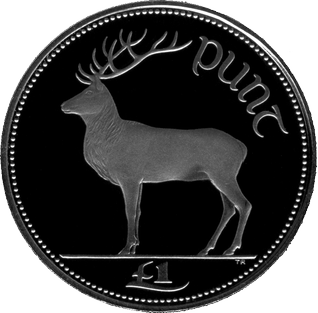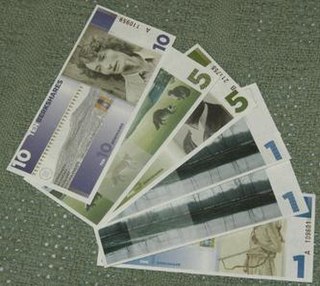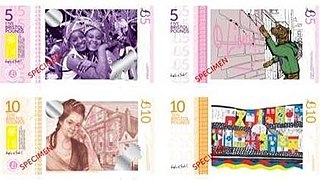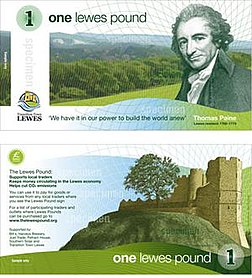The Australian dollar is the official currency and legal tender of Australia, including all of its external territories, and three independent sovereign Pacific Island states: Kiribati, Nauru, and Tuvalu. As of 2022, it is currently the sixth most-traded currency in the foreign exchange market and also the seventh most-held reserve currency in global reserves.
The New Zealand dollar is the official currency and legal tender of New Zealand, the Cook Islands, Niue, the Ross Dependency, Tokelau, and a British territory, the Pitcairn Islands. Within New Zealand, it is almost always abbreviated with the dollar sign ($). The abbreviations "$NZ" or "NZ$" are sometimes used when necessary to distinguish it from other dollar-denominated currencies.

The pound was the currency of the Republic of Ireland until 2002. Its ISO 4217 code was IEP, and the symbol was £ The Irish pound was replaced by the euro on 1 January 1999. Euro currency did not begin circulation until the beginning of 2002.

Sterling banknotes are the banknotes in circulation in the United Kingdom and its related territories, denominated in pounds sterling.

The South African rand, or simply the rand, is the official currency of the Southern African Common Monetary Area: South Africa, Namibia, Lesotho and Eswatini. It is subdivided into 100 cents.
The Korean People's won, sometimes known as the North Korean won or Democratic People's Republic of Korea won, is the official currency of North Korea. It is subdivided into 100 chon. The currency is issued by the Central Bank of the Democratic People's Republic of Korea, based in the North Korean capital city of Pyongyang.

The pound, or lira, was the currency of Cyprus, including the Sovereign Base Areas in Akrotiri and Dhekelia, from 1879 to 2007, when the Republic of Cyprus adopted the euro. However, the self-proclaimed Turkish Republic of Northern Cyprus uses the Turkish lira as its official currency.
The Bermudian dollar is the official currency of the British Overseas Territory of Bermuda. It is subdivided into 100 cents. The Bermudian dollar is not normally traded outside Bermuda, and is pegged to the United States dollar at a one-to-one ratio. Both currencies circulate in Bermuda on an equal basis.

The Fijian dollar has been the currency of Fiji since 1969 and was also the currency between 1867 and 1873. It is normally abbreviated with the dollar sign $, or alternatively FJ$ to distinguish it from other dollar-denominated currencies. It is divided into 100 cents.

The Jamaican dollar has been the currency of Jamaica since 1969. It is often abbreviated to J$, the J serving to distinguish it from other dollar-denominated currencies. It is divided into 100 cents, although cent denominations are no longer in use as of 2018. Goods and services may still be priced in cents, but cash transactions are now rounded to the nearest dollar.
The tögrög or tugrik is the official currency of Mongolia. It was historically subdivided into 100 möngö. Currently, the lowest denomination in regular use is the 10-tögrög note and the highest is the 20,000-tögrög note. In Unicode, the currency sign is U+20AE₮TUGRIK SIGN.
The pound is the currency of the Falkland Islands, a British Overseas Territory in the South Atlantic Ocean. The symbol is the pound sign, £. The ISO 4217 currency code is FKP.
A private currency is a currency issued by a private entity, be it an individual, a commercial business, a nonprofit or decentralized common enterprise. It is often contrasted with fiat currency issued by governments or central banks. In many countries, the issuance of private paper currencies and/or the minting of metal coins intended to be used as currency may even be a criminal act such as in the United States. Digital cryptocurrency is sometimes treated as an asset instead of a currency. Cryptocurrency is illegal as a currency in a few countries.

BerkShares is a local currency that circulates in The Berkshires region of Massachusetts. It was launched on September 29, 2006 by BerkShares Inc., with research and development assistance from the Schumacher Center for a New Economics. The BerkShares website lists around 400 businesses in Berkshire County that accept the currency. Since launch, over 10 million BerkShares have been issued from participating branch offices of local banks. The bills were designed by John Isaacs and were printed by Excelsior Printing on special paper with incorporated security features from Crane & Co. BerkShares are pegged with an exchange rate to the US dollar, but the Schumacher Center has discussed the possibility of pegging its value to a basket of local goods in order to insulate the local economy against volatility in the US economy.
The Totnes pound (t£) was a complementary local currency, intended to support the local economy of Totnes, a town in Devon, England. It was in circulation from March 2007 to June 2019, when it was discontinued due partly to an increasingly cashless economy.

The terms transition town, transition initiative and transition model refer to grassroot community projects that aim to increase self-sufficiency to reduce the potential effects of peak oil, climate destruction, and economic instabilitythrough renewed localization strategies, especially around food production and energy usage. In 2006, the founding of Transition Town Totnes in the United Kingdom became an inspiration for other groups to form. The Transition Network charity was founded in early 2007, to support these projects. A number of the groups are officially registered with the Transition Network. Transition initiatives have been started in locations around the world, with many located in the United Kingdom and others in Europe, North America and Australia. While the aims remain the same, Transition initiatives' solutions are specific depending on the characteristics of the local area.
The Stroud pound is a local currency in use in Stroud, Gloucestershire. Unveiled on 12 September 2009, the scheme is the third local currency scheme introduced in England in recent years after the Totnes pound and the Lewes pound.
Fiscal localism comprises institutions of localized monetary exchange. Sometimes considered a backlash against global capitalism or economic globalization, fiscal localism affords voluntary, market structures that help communities trade more efficiently within their communities and regions.

The Bristol pound (£B) was a form of local, complementary, and/or community currency launched in Bristol, UK on 19 September 2012. Its objective is to encourage people to spend their money with local, independent businesses in Bristol, and for those businesses to in turn localise their own supply chains. At the point of the close of the digital scheme in August 2020, it was the largest alternative in the UK to official sterling currency, and is backed by sterling.

The Exeter pound (£E) was a form of local complementary currency, or community currency launched in Exeter, UK on 1 September 2015. Its objective was to ensure more money was spent with local and independent businesses. It was one of the many alternatives in the UK to the official sterling currency. It was discontinued on 30 September 2018.










